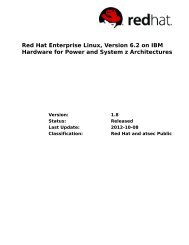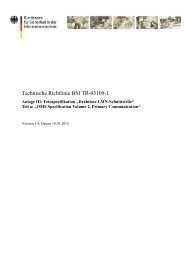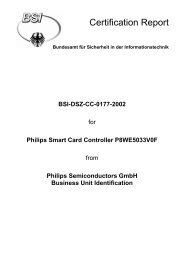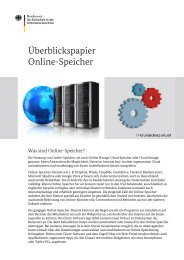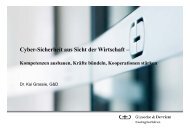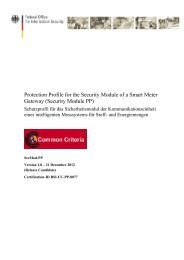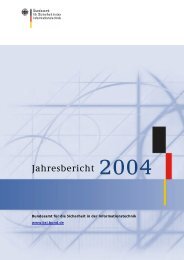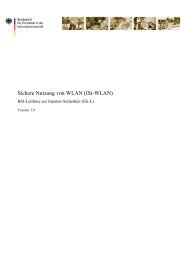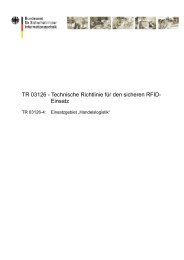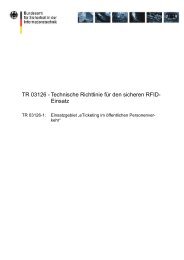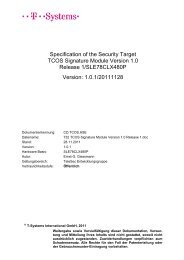Certification Report BSI-DSZ-CC-0386-2006 - Bundesamt für ...
Certification Report BSI-DSZ-CC-0386-2006 - Bundesamt für ...
Certification Report BSI-DSZ-CC-0386-2006 - Bundesamt für ...
You also want an ePaper? Increase the reach of your titles
YUMPU automatically turns print PDFs into web optimized ePapers that Google loves.
<strong>Certification</strong> <strong>Report</strong><br />
<strong>Bundesamt</strong> <strong>für</strong> Sicherheit in der Informationstechnik<br />
<strong>BSI</strong>-<strong>DSZ</strong>-<strong>CC</strong>-<strong>0386</strong>-<strong>2006</strong><br />
for<br />
ZKA SE<strong>CC</strong>OS Sig v1.5.3<br />
from<br />
Sagem Orga GmbH
<strong>BSI</strong> - <strong>Bundesamt</strong> <strong>für</strong> Sicherheit in der Informationstechnik, Postfach 20 03 63, D-53133 Bonn<br />
Phone +49 (0)3018 9582-0, Fax +49 (0)3018 9582-5455, Infoline +49 (0)3018 9582-111<br />
<strong>Certification</strong> <strong>Report</strong> V1.0 ZS-01-01-F-330 V3.31
<strong>BSI</strong>-<strong>DSZ</strong>-<strong>CC</strong>-<strong>0386</strong>-<strong>2006</strong><br />
ZKA SE<strong>CC</strong>OS Sig v1.5.3<br />
from<br />
Sagem Orga GmbH Common Criteria Arrangement<br />
for components up to EAL4<br />
The IT product identified in this certificate has been evaluated at an accredited and licensed/<br />
approved evaluation facility using the Common Methodology for IT Security Evaluation, Version 2.3<br />
(ISO/IEC 15408:2005) extended by advice of the <strong>Certification</strong> Body for components beyond EAL4<br />
and smart card specific guidance for conformance to the Common Criteria for IT Security<br />
Evaluation, Version 2.3 (ISO/IEC 15408:2005).<br />
Evaluation Results:<br />
Functionality: Product specific Security Target<br />
Common Criteria Part 2 extended<br />
Assurance Package: Common Criteria Part 3 conformant<br />
EAL4 augmented by<br />
AVA_MSU.3 (Vulnerability assessment - Analysis and testing for<br />
insecure states)<br />
AVA_VLA.4 (Vulnerability assessment - Highly resistant)<br />
This certificate applies only to the specific version and release of the product in its evaluated<br />
configuration and in conjunction with the complete <strong>Certification</strong> <strong>Report</strong>.<br />
The evaluation has been conducted in accordance with the provisions of the certification scheme<br />
of the German Federal Office for Information Security (<strong>BSI</strong>) and the conclusions of the evaluation<br />
facility in the evaluation technical report are consistent with the evidence adduced.<br />
The notes mentioned on the reverse side are part of this certificate.<br />
Bonn, 08. September <strong>2006</strong><br />
The Vice President of the Federal Office<br />
for Information Security<br />
Hange L.S.<br />
<strong>Bundesamt</strong> <strong>für</strong> Sicherheit in der Informationstechnik<br />
Godesberger Allee 185-189 - D-53175 Bonn - Postfach 20 03 63 - D-53133 Bonn<br />
Phone +49 228 9582-0 - Fax +49 228 9582-5455 - Infoline +49 228 9582-111
The rating of the strength of functions does not include the cryptoalgorithms suitable for encryption<br />
and decryption (see <strong>BSI</strong>G Section 4, Para. 3, Clause 2)<br />
This certificate is not an endorsement of the IT product by the Federal Office for Information<br />
Security or any other organisation that recognises or gives effect to this certificate, and no warranty<br />
of the IT product by the Federal Office for Information Security or any other organisation that<br />
recognises or gives effect to this certificate, is either expressed or implied.
<strong>BSI</strong>-<strong>DSZ</strong>-<strong>CC</strong>-<strong>0386</strong>-<strong>2006</strong> <strong>Certification</strong> <strong>Report</strong><br />
Preliminary Remarks<br />
Under the <strong>BSI</strong>G 1 Act, the Federal Office for Information Security (<strong>BSI</strong>) has the<br />
task of issuing certificates for information technology products.<br />
<strong>Certification</strong> of a product is carried out on the instigation of the vendor or a<br />
distributor, hereinafter called the sponsor.<br />
A part of the procedure is the technical examination (evaluation) of the product<br />
according to the security criteria published by the <strong>BSI</strong> or generally recognised<br />
security criteria.<br />
The evaluation is normally carried out by an evaluation facility recognised by the<br />
<strong>BSI</strong> or by <strong>BSI</strong> itself.<br />
The result of the certification procedure is the present <strong>Certification</strong> <strong>Report</strong>. This<br />
report contains among others the certificate (summarised assessment) and the<br />
detailed <strong>Certification</strong> Results.<br />
The <strong>Certification</strong> Results contain the technical description of the security<br />
functionality of the certified product, the details of the evaluation (strength and<br />
weaknesses) and instructions for the user.<br />
1 Act setting up the Federal Office for Information Security (<strong>BSI</strong>-Errichtungsgesetz, <strong>BSI</strong>G) of<br />
17 December 1990, Bundesgesetzblatt I p. 2834<br />
V
<strong>Certification</strong> <strong>Report</strong> <strong>BSI</strong>-<strong>DSZ</strong>-<strong>CC</strong>-<strong>0386</strong>-<strong>2006</strong><br />
Contents<br />
Part A: <strong>Certification</strong><br />
Part B: <strong>Certification</strong> Results<br />
Part C: Excerpts from the Criteria<br />
VI
<strong>BSI</strong>-<strong>DSZ</strong>-<strong>CC</strong>-<strong>0386</strong>-<strong>2006</strong> <strong>Certification</strong> <strong>Report</strong><br />
A <strong>Certification</strong><br />
1 Specifications of the <strong>Certification</strong> Procedure<br />
The certification body conducts the procedure according to the criteria laid down<br />
in the following:<br />
• <strong>BSI</strong>G 2<br />
• <strong>BSI</strong> <strong>Certification</strong> Ordinance 3<br />
• <strong>BSI</strong> Schedule of Costs 4<br />
• Special decrees issued by the Bundesministerium des Innern (Federal<br />
Ministry of the Interior)<br />
• DIN EN 45011 standard<br />
• <strong>BSI</strong> certification: Procedural Description (<strong>BSI</strong> 7125)<br />
• Common Criteria for IT Security Evaluation (<strong>CC</strong>), version 2.3 5<br />
• Common Methodology for IT Security Evaluation (CEM), version 2.3<br />
• <strong>BSI</strong> certification: Application Notes and Interpretation of the Scheme (AIS)<br />
• Advice from the <strong>Certification</strong> Body on methodology for assurance<br />
components above EAL4 (AIS 34)<br />
2 Act setting up the Federal Office for Information Security (<strong>BSI</strong>-Errichtungsgesetz, <strong>BSI</strong>G) of<br />
17 December 1990, Bundesgesetzblatt I p. 2834<br />
3 Ordinance on the Procedure for Issuance of a Certificate by the Federal Office for<br />
Information Security (<strong>BSI</strong>-Zertifizierungsverordnung, <strong>BSI</strong>ZertV) of 7 July 1992,<br />
Bundesgesetzblatt I p. 1230<br />
4 Schedule of Cost for Official Procedures of the <strong>Bundesamt</strong> <strong>für</strong> Sicherheit in der<br />
Informationstechnik (<strong>BSI</strong>-Kostenverordnung, <strong>BSI</strong>-KostV) of 03 March 2005,<br />
Bundesgesetzblatt I p. 519<br />
5 Proclamation of the Bundesministerium des Innern of 10 May <strong>2006</strong> in the Bundesanzeiger<br />
dated 19 May <strong>2006</strong>, p. 3730<br />
A-1
<strong>Certification</strong> <strong>Report</strong> <strong>BSI</strong>-<strong>DSZ</strong>-<strong>CC</strong>-<strong>0386</strong>-<strong>2006</strong><br />
2 Recognition Agreements<br />
In order to avoid multiple certification of the same product in different countries<br />
a mutual recognition of IT security certificates - as far as such certificates are<br />
based on ITSEC or <strong>CC</strong> - under certain conditions was agreed.<br />
2.1 ITSEC/<strong>CC</strong> - Certificates<br />
The SOGIS-Agreement on the mutual recognition of certificates based on<br />
ITSEC became effective on 3 March 1998. This agreement was signed by the<br />
national bodies of Finland, France, Germany, Greece, Italy, The Netherlands,<br />
Norway, Portugal, Spain, Sweden, Switzerland and the United Kingdom. This<br />
agreement on the mutual recognition of IT security certificates was extended to<br />
include certificates based on the <strong>CC</strong> for all evaluation levels (EAL 1 – EAL 7).<br />
2.2 <strong>CC</strong> - Certificates<br />
An arrangement (Common Criteria Arrangement) on the mutual recognition of<br />
certificates based on the <strong>CC</strong> evaluation assurance levels up to and including<br />
EAL 4 was signed in May 2000. It includes also the recognition of Protection<br />
Profiles based on the <strong>CC</strong>. The arrangement was signed by the national bodies<br />
of Australia, Canada, Finland, France, Germany, Greece, Italy, The<br />
Netherlands, New Zealand, Norway, Spain, United Kingdom and the United<br />
States. Israel joined the arrangement in November 2000, Sweden in February<br />
2002, Austria in November 2002, Hungary and Turkey in September 2003,<br />
Japan in November 2003, the Czech Republic in September 2004, the Republic<br />
of Singapore in March 2005, India in April 2005.<br />
This evaluation contains the components AVA_MSU.3 (Vulnerability<br />
assessment - Analysis and testing for insecure states) and AVA_VLA.4<br />
(Vulnerability assessment - Highly resistant) that are not mutually recognised in<br />
accordance with the provisions of the <strong>CC</strong>RA. For mutual recognition the EAL4<br />
components of these assurance families are relevant.<br />
A-2
<strong>BSI</strong>-<strong>DSZ</strong>-<strong>CC</strong>-<strong>0386</strong>-<strong>2006</strong> <strong>Certification</strong> <strong>Report</strong><br />
3 Performance of Evaluation and <strong>Certification</strong><br />
The certification body monitors each individual evaluation to ensure a uniform<br />
procedure, a uniform interpretation of the criteria and uniform ratings.<br />
The product ZKA SE<strong>CC</strong>OS Sig v1.5.3 has undergone the certification<br />
procedure at <strong>BSI</strong>. This is a re-certification based on <strong>BSI</strong>-<strong>DSZ</strong>-<strong>CC</strong>-0341-<strong>2006</strong>.<br />
The evaluation of the product ZKA SE<strong>CC</strong>OS Sig v1.5.3 was conducted by SRC<br />
Security Research & Consulting GmbH. The SRC Security Research &<br />
Consulting GmbH is an evaluation facility (ITSEF) 6 recognised by <strong>BSI</strong>.<br />
The sponsor, vendor and distributor is:<br />
Sagem Orga GmbH<br />
Am Hoppenhof 33<br />
33104 Paderborn<br />
Germany<br />
The certification is concluded with<br />
• the comparability check and<br />
• the production of this <strong>Certification</strong> <strong>Report</strong>.<br />
This work was completed by the <strong>BSI</strong> on 08. September <strong>2006</strong>.<br />
The confirmed assurance package is only valid on the condition that<br />
• all stipulations regarding generation, configuration and operation, as given in<br />
the following report, are observed,<br />
• the product is operated in the environment described, where specified in the<br />
following report.<br />
This <strong>Certification</strong> <strong>Report</strong> only applies to the version of the product indicated<br />
here. The validity can be extended to new versions and releases of the product,<br />
provided the sponsor applies for re-certification of the modified product, in<br />
accordance with the procedural requirements, and the evaluation does not<br />
reveal any security deficiencies.<br />
For the meaning of the assurance levels and the confirmed strength of<br />
functions, please refer to the excerpts from the criteria at the end of the<br />
<strong>Certification</strong> <strong>Report</strong>.<br />
6 Information Technology Security Evaluation Facility<br />
A-3
<strong>Certification</strong> <strong>Report</strong> <strong>BSI</strong>-<strong>DSZ</strong>-<strong>CC</strong>-<strong>0386</strong>-<strong>2006</strong><br />
4 Publication<br />
The following <strong>Certification</strong> Results contain pages B-1 to B-24.<br />
The product ZKA SE<strong>CC</strong>OS Sig v1.5.3 has been included in the <strong>BSI</strong> list of the<br />
certified products, which is published regularly (see also Internet: http://<br />
www.bsi.bund.de). Further information can be obtained from <strong>BSI</strong>-Infoline +49<br />
228 9582-111.<br />
Further copies of this <strong>Certification</strong> <strong>Report</strong> can be requested from the vendor 7 of<br />
the product. The <strong>Certification</strong> <strong>Report</strong> can also be downloaded from the abovementioned<br />
website.<br />
7 Sagem Orga GmbH<br />
Am Hoppenhof 33<br />
33104 Paderborn<br />
Germany<br />
A-4
<strong>BSI</strong>-<strong>DSZ</strong>-<strong>CC</strong>-<strong>0386</strong>-<strong>2006</strong> <strong>Certification</strong> <strong>Report</strong><br />
B <strong>Certification</strong> Results<br />
The following results represent a summary of<br />
• the security target of the sponsor for the target of evaluation,<br />
• the relevant evaluation results from the evaluation facility, and<br />
• complementary notes and stipulations of the certification body.<br />
B-1
<strong>Certification</strong> <strong>Report</strong> <strong>BSI</strong>-<strong>DSZ</strong>-<strong>CC</strong>-<strong>0386</strong>-<strong>2006</strong><br />
Contents of the certification results<br />
1 Executive Summary 3<br />
2 Identification of the TOE 11<br />
3 Security Policy 12<br />
4 Assumptions and Clarification of Scope 13<br />
5 Architectural Information 13<br />
6 Documentation 14<br />
7 IT Product Testing 14<br />
8 Evaluated Configuration 15<br />
9 Results of the Evaluation 16<br />
10 Comments/Recommendations 18<br />
11 Annexes 19<br />
12 Security Target 19<br />
13 Definitions 19<br />
14 Bibliography 22<br />
B-2
<strong>BSI</strong>-<strong>DSZ</strong>-<strong>CC</strong>-<strong>0386</strong>-<strong>2006</strong> <strong>Certification</strong> <strong>Report</strong><br />
1 Executive Summary<br />
The Target of Evaluation (TOE) is the smartcard product ZKA SE<strong>CC</strong>OS Sig<br />
v1.5.3 developed by Sagem Orga GmbH. It is a re-evaluation of ZKA SE<strong>CC</strong>OS<br />
Sig v1.5.2 which is certified unter the certification ID <strong>BSI</strong>-<strong>DSZ</strong>-341-<strong>2006</strong>, see<br />
[23] and [24]. The re-evaluation was done mainly due to the addition of new<br />
routines to compute SHA-256 hash values in the Renesas cryptographic library<br />
ACL which was certified under the certification ID <strong>BSI</strong>-<strong>DSZ</strong>-<strong>CC</strong>-0379-<strong>2006</strong>, see<br />
[9] and [10].<br />
The TOE is realised as Smartcard Integrated Circuit (IC with contacts) with<br />
Cryptographic Library, Smartcard Embedded Software and the EEPROM part<br />
containing a dedicated Signature Application.<br />
The Smartcard Embedded Software comprises the so-called SE<strong>CC</strong>OS<br />
operating system. This platform provides a fully interoperable ISO 7816<br />
compliant multi-application platform.<br />
The TOE is intended to be used as Secure Signature-Creation Device (SSCD)<br />
for qualified electronic signatures in accordance with the European Directive<br />
1999/93/EC on electronic signatures [13], the German Signature Act [14], the<br />
German Signature Change Act (Signaturänderungsgesetz) [22], and the<br />
German Signature Ordinance [15].<br />
The TOE as SSCD is configured software and hardware used to implement the<br />
Signature-Creation Data (SCD) and to guarantee for the secure usage of the<br />
SCD and comprises the following components:<br />
• Integrated Circuit (IC) AE55C1 (HD65255C1), Version 02 with related<br />
Advanced Cryptographic Library, Version 1.43 incl. module SHA-256 (ACL)<br />
provided by Renesas Technology Corp. certified under <strong>BSI</strong>-<strong>DSZ</strong>-<strong>CC</strong>-0379-<br />
<strong>2006</strong>, see [9] and [10].<br />
• Smartcard Embedded Software comprising the SE<strong>CC</strong>OS operating system<br />
platform provided by Sagem Orga GmbH<br />
• EEPROM Initialisation Tables with the dedicated Signature Application<br />
provided by Sagem Orga GmbH and including additional applications<br />
The TOE provides the following functions necessary for devices involved in<br />
creating qualified electronic signatures according to the SSCD Type 3<br />
Protection Profile [12]:<br />
• Generation of the SCD and the correspondent Signature-Verification Data<br />
(SVD)<br />
• Creation of qualified electronic signatures<br />
(a) after allowing for the data to be signed (DTBS) to be displayed<br />
correctly where the display function has to be provided by an<br />
appropriate environment<br />
B-3
<strong>Certification</strong> <strong>Report</strong> <strong>BSI</strong>-<strong>DSZ</strong>-<strong>CC</strong>-<strong>0386</strong>-<strong>2006</strong><br />
(b) using appropriate hash functions that are, according to [16], agreed as<br />
suitable for qualified electronic signatures<br />
(c) after appropriate authentication of the signatory by the TOE<br />
(d) using appropriate cryptographic signature functions that employ<br />
appropriate cryptographic parameters agreed as suitable according to<br />
[16].<br />
To prevent the unauthorised usage of the SCD, the TOE provides user<br />
authentication and access control. The user authenticates himself by supplying<br />
the verification authentication data (VAD) to the TOE which compares the VAD<br />
against the reference authentication data (RAD) securely stored inside the TOE.<br />
The TOE implements IT measures to support a trusted path to a trusted human<br />
interface device that can optionally be connected via a trusted channel with the<br />
TOE.<br />
The TOE does not implement the Signature-Creation Application (SCA) which<br />
presents the data to be signed (DTBS) to the signatory and prepares the DTBSrepresentation<br />
the signatory wishes to sign for performing the cryptographic<br />
function of the signature. The SCA belongs to the environment of the TOE.<br />
The TOE protects the SCD during the whole life-cycle as to be solely used in<br />
the signature-creation process by the legitimate signatory. The TOE as SSCD<br />
of Type 3 generates the signatory’s SCD oncard and serves for a secure<br />
storage of this data. The initialisation and personalisation of the TOE for the<br />
signatory‘s use in the sense of the Protection Profile [12] include:<br />
• Generation of the SCD/SVD pair<br />
• Personalisation for the signatory by means of the signatory’s verification<br />
authentication data (VAD).<br />
From the structural perspective, the TOE as SSCD comprises the underlying IC<br />
including the related ACL, the SE<strong>CC</strong>OS operating system and the Signature<br />
Application with SCD/SVD generation, SCD storage and use, SVD export, and<br />
the signature-creation functionality. The SCA and the CGA (beside additional<br />
other applications) are part of the immediate environment of the TOE. They may<br />
communicate with the TOE over a trusted channel, a trusted path for the human<br />
interface provided by the SCA, respectively. In case a trusted channel or trusted<br />
path is not established with cryptographic means the TOE shall only be used<br />
within a Trusted Environment.<br />
The TOE as a multi-application smart card implements additional applications<br />
that are not part of the TOE.<br />
The evaluation of the TOE was conducted as a composition evaluation making<br />
use of the platform evaluation results of the <strong>CC</strong> evaluation of the underlying<br />
semiconductor, the Renesas AE55C1 (HD65255C1) smartcard integrated<br />
circuit version 02 with ACL version 1.43 and additional SHA-256 function<br />
provided by Renesas Technology Corp. and which was evaluated as <strong>BSI</strong>-<strong>DSZ</strong>-<br />
<strong>CC</strong>-0379-<strong>2006</strong> ([9] and [10]). The IC was evaluated according to Common<br />
Criteria EAL 4 augmented with a minimum strength level for its security<br />
B-4
<strong>BSI</strong>-<strong>DSZ</strong>-<strong>CC</strong>-<strong>0386</strong>-<strong>2006</strong> <strong>Certification</strong> <strong>Report</strong><br />
functions of SOF-high for specific functionality based on the Protection Profile<br />
<strong>BSI</strong>-PP-0002 [11] and as outlined in [9] and [10]. This platform evaluation was<br />
performed by T-Systems GEI GmbH.<br />
The IT product ZKA SE<strong>CC</strong>OS Sig v1.5.3 was evaluated by SRC Security<br />
Research & Consulting GmbH. The evaluation was completed on 02. August<br />
<strong>2006</strong>. The SRC Security Research & Consulting GmbH is an evaluation facility<br />
(ITSEF) 8 recognised by <strong>BSI</strong>.<br />
The sponsor, vendor and distributor is<br />
Sagem Orga GmbH<br />
Am Hoppenhof 33<br />
33104 Paderborn<br />
Germany<br />
1.1 Assurance package<br />
The TOE security assurance requirements are based entirely on the assurance<br />
components defined in part 3 of the Common Criteria (see Annex C or [1], part<br />
3 for details). The TOE meets the assurance requirements of assurance level<br />
EAL4 (Evaluation Assurance Level 4 augmented). The following table shows<br />
the augmented assurance components.<br />
Requirement Identifier<br />
EAL4 TOE evaluation: methodically designed, tested, and reviewed<br />
+ AVA_MSU.3 Vulnerability assessment - Analysis and testing for insecure<br />
states<br />
+ AVA_VLA.4 Vulnerability assessment – Highly resistant<br />
1.2 Functionality<br />
Table 1: Assurance components and EAL-augmentation<br />
The TOE Security Functional Requirements (SFR) selected in the Security<br />
Target [6] are Common Criteria Part 2 extended as shown in the following<br />
tables.<br />
The following SFRs are taken from the SSCD Type 3 PP [12] and from <strong>CC</strong> part<br />
2:<br />
Security Functional Requirement Addressed issue<br />
FCS Cryptographic support<br />
FCS_CKM.1 Cryptographic key generation<br />
8 Information Technology Security Evaluation Facility<br />
B-5
<strong>Certification</strong> <strong>Report</strong> <strong>BSI</strong>-<strong>DSZ</strong>-<strong>CC</strong>-<strong>0386</strong>-<strong>2006</strong><br />
B-6<br />
Security Functional Requirement Addressed issue<br />
FCS_CKM.4 Cryptographic key destruction<br />
FCS_COP.1 Cryptographic operation<br />
FDP User data protection<br />
FDP_A<strong>CC</strong>.1 Subset access control<br />
FDP_ACF.1 Security attribute based access control<br />
FDP_ETC.1 Export of user data without security<br />
attributes<br />
FDP_ITC.1 Import of user data without security<br />
attributes<br />
FDP_RIP.1 Subset residual information protection<br />
FDP_SDI.2 Stored data integrity monitoring and action<br />
FDP_UIT.1 Data exchange integrity<br />
FIA Identification and authentication<br />
FIA_AFL.1 Authentication failure handling<br />
FIA_ATD.1 User attribute definition<br />
FIA_UAU.1 Timing of authentication<br />
FIA_UID.1 Timing of identification<br />
FMT Security Management<br />
FMT_MOF.1 Management of security functions behaviour<br />
FMT_MSA.1 Management of security attributes<br />
FMT_MSA.2 Secure security attributes<br />
FMT_MSA.3 Static attribute initialisation<br />
FMT_MTD.1 Management of TSF data<br />
FMT_SMF.1 Specification of management functions<br />
FMT_SMR.1 Security roles<br />
FPT Protection of the TOE Security Functions<br />
FPT_AMT.1 Abstract machine testing<br />
FPT_FLS.1 Failure with preservation of secure state<br />
FPT_PHP.1 Passive detection of physical attack<br />
FPT_PHP.3 Resistance to physical attack<br />
FPT_TST.1 TSF testing<br />
FTP Trusted Path/Channels<br />
FTP_ITC.1 Inter-TSF trusted channel<br />
FTP_TRP.1 Trusted path<br />
Table 2: SFRs for the TOE taken from <strong>CC</strong> Part 2
<strong>BSI</strong>-<strong>DSZ</strong>-<strong>CC</strong>-<strong>0386</strong>-<strong>2006</strong> <strong>Certification</strong> <strong>Report</strong><br />
The following <strong>CC</strong> part 2 extended SFRs are defined:<br />
Security Functional Requirement Addressed issue<br />
FPT Protection of the TOE Security Functions<br />
FPT_EMSEC.1 TOE Emanation<br />
Table 3: SFRs for the TOE, <strong>CC</strong> part 2 extended<br />
Note: only the titles of the Security Functional Requirements are provided. For<br />
more details and application notes please refer to the ST [6] chapter 5.<br />
The following Security Functional Requirements are defined for the <strong>Certification</strong><br />
Generation Application (CGA) in the IT- Environment of the TOE:<br />
Security Functional Requirement Addressed issue<br />
FCS Cryptographic support<br />
FCS_CKM.2 Cryptographic key distribution<br />
FCS_CKM.3 Cryptographic key access<br />
FDP User data protection<br />
FDP_UIT.1 Data exchange integrity<br />
FTP Trusted Path/Channels<br />
FTP_ITC.1 Inter-TSF trusted channel<br />
Table 4: SFRs for the CGA in the IT-Environment<br />
The following Security Functional Requirements are defined for the Signature<br />
Creation Application (SCA) in the IT- Environment of the TOE:<br />
Security Functional Requirement Addressed issue<br />
FCS Cryptographic support<br />
FCS_COP.1 Cryptographic operation<br />
FDP User data protection<br />
FDP_UIT.1 Data exchange integrity<br />
FTP Trusted Path/Channels<br />
FTP_ITC.1 Inter-TSF trusted channel<br />
FTP_TRP.1 Trusted Path<br />
Table 5: SFRs for the SCA in the IT-Environment<br />
Note: only the titles of the Security Functional Requirements are provided. For<br />
more details and application notes please refer to the ST [6], chapter 5.2.1.<br />
For a detailed overview of the SFRs defined for the underlying IC and ACL refer<br />
to [10], Chapter 5.1.1, 8.4, 8.5 and 8.6.<br />
B-7
<strong>Certification</strong> <strong>Report</strong> <strong>BSI</strong>-<strong>DSZ</strong>-<strong>CC</strong>-<strong>0386</strong>-<strong>2006</strong><br />
These Security Functional Requirements are implemented by the TOE Security<br />
Functions:<br />
TOE Security Function Addressed issue<br />
Access Control<br />
F.ACS_SIG Security Attribute Based Access Control / ZKA-SigG-Q<br />
Application<br />
F.ADMIN_SIG Administration of the TOE / ZKA-SigG-Q Application<br />
Identification and Authentication<br />
F.PIN_SIG PIN Based User Authentication for the Signatory<br />
Integrity of Stored Data<br />
F.DATA_INT Stored Data Integrity Monitoring and Action<br />
Secure Data Exchange<br />
F.SEC_EXCH Integrity and Confidentiality of Data Exchange<br />
Object Reuse<br />
F.RIP Residual Information Protection<br />
Protection<br />
F.FAIL_PROT Hardware and Software Failure Protection<br />
F.SIDE_CHAN Side Channel Analysis Control<br />
F.SELFTEST Self Test<br />
Cryptographic Operations<br />
F.CRYPTO Cryptographic Support<br />
F.RSA_KEYGEN RSA Key Pair Generation<br />
F.GEN_SIG RSA Generation of Electronic Signatures<br />
Table 6: TOE Security Functions<br />
For more details please refer to the Security Target [6], chapter 6.<br />
For a detailed overview of the TOE Security Functions defined for the<br />
underlying IC and ACL refer to [10].<br />
1.3 Strength of Function<br />
The TOE’s strength of functions is claimed high (SOF-high) for specific<br />
functions as indicated in the Security Target [6], chapter 6.2.<br />
The rating of the strength of functions does not include the cryptoalgorithms<br />
suitable for encryption and decryption (see <strong>BSI</strong>G Section 4, Para. 3, Clause 2).<br />
For details see chapter 9 of this report.<br />
B-8
<strong>BSI</strong>-<strong>DSZ</strong>-<strong>CC</strong>-<strong>0386</strong>-<strong>2006</strong> <strong>Certification</strong> <strong>Report</strong><br />
1.4 Summary of threats and Organisational Security Policies<br />
(OSPs) addressed by the evaluated IT product<br />
The threats and Organisational Security Policies (OSPs) which were assumed<br />
for the evaluation and averted by the TOE are specified in the Security Target<br />
[6]:<br />
Name Definition<br />
T.Hack_Phys Physical attacks through the TOE interfaces<br />
T.SCD_Divulg Storing, copying, and releasing of the signature creation data<br />
T.SCD_Derive Derive the signature creation data<br />
T.Sig_Forgery Forgery of the electronic signature<br />
T.Sig_Repud Repudiation of signatures<br />
T.SVD_Forgery Forgery of the signature-verification data<br />
T.DTBS_Forgery Forgery of the DTBS-representation<br />
T.SigF_Misuse Misuse of the signature creation function of the TOE<br />
T.INIT_Aut Authentication for Initialisation Process<br />
T.INIT_Data Loading of Manipulated Initialisation Data<br />
T.PERS_Aut Authentication for Personalisation Process<br />
T.PERS_Data Modification or Disclosure of Personalisation Data<br />
Name Definition<br />
Table 7: Threats for the TOE<br />
P.CSP_Qcert Qualified certificate<br />
P.Qsign Qualified electronic signatures<br />
P.Sigy_SSCD TOE as secure signature creation device<br />
Table 8: OSPs<br />
Note: Only the titles of the threats and OSPs are provided. For more details<br />
please refer to the Security Target [6], chapter 3, where also assets and<br />
subjects of the TOE are described.<br />
1.5 Special configuration requirements<br />
The TOE is intended to be used as a secure signature creation device. It is<br />
defined uniquely by the name and version number ZKA SE<strong>CC</strong>OS Sig v1.5.3. Its<br />
implementation representation and its configuration are specified by the<br />
Configuration List [21].<br />
The evaluation results are restricted to chip cards or modules containing the<br />
TOE in combination with other applications that are listed below in table 9. All<br />
applications are listed in the table below. During the evaluation, tests have been<br />
B-9
<strong>Certification</strong> <strong>Report</strong> <strong>BSI</strong>-<strong>DSZ</strong>-<strong>CC</strong>-<strong>0386</strong>-<strong>2006</strong><br />
performed to demonstrate that the separation mechanism of the SE<strong>CC</strong>OS<br />
Application Layer realises a separation between these additional applications<br />
and the dedicated Signature Application. The additional applications did not<br />
influence the security of the Signature Application.<br />
Application Name AID (Application<br />
Identifier)<br />
MF<br />
MF<br />
Signature application<br />
DF_SIG<br />
Zusatzanwendungen<br />
ZA_MF_NEU<br />
ec-Cash<br />
DF_EC_CASH_NEU<br />
Geldkarte<br />
DF_BOERSE_NEU<br />
GA-Maestro<br />
DF_GA_MAESTRO<br />
TAN-Anwendung<br />
DF_TAN<br />
Marktplatz<br />
DF_MARKTPLATZ_NEU<br />
Fahrschein<br />
DF_FAHRSCHEIN_NEU<br />
HBCI<br />
DF_BANKING_20<br />
Notepad<br />
DF_NOTEPAD<br />
3F 00 52 4F 4F 54<br />
Application name in the card<br />
AB 00 D2 76 00 00 66 01<br />
A7 00 D2 76 00 00 25 5A 41 02 00<br />
A1 00 D2 76 00 00 25 45 43 02 00<br />
A2 00 D2 76 00 00 25 45 50 02 00<br />
A0 00 00 00 59 50 41 43 45 01 00<br />
AC 00 D2 76 00 00 25 47 41 01 00<br />
A0 00 00 00 04 30 60<br />
AC 02 D2 76 00 00 25 54 44 01 00<br />
B0 01 D2 76 00 00 25 4D 01 02 00<br />
B0 00 D2 76 00 00 25 46 53 02 00<br />
A6 00 D2 76 00 00 25 48 42 02 00<br />
A6 10 D2 76 00 00 25 4E 50 01 00<br />
Table 9: Signature application and optional applications<br />
1.6 Assumptions about the operating environment<br />
The following constraints concerning the operating environment are made in the<br />
Security Target, please refer to the Security Target [6], chapter 3.2:<br />
A.CGA Trustworthy certification-generation application<br />
B-10<br />
The CGA protects the authenticity of the signatory’s name<br />
and the SVD in the qualified certificate by an advanced<br />
signature of the CSP.
<strong>BSI</strong>-<strong>DSZ</strong>-<strong>CC</strong>-<strong>0386</strong>-<strong>2006</strong> <strong>Certification</strong> <strong>Report</strong><br />
A.SCA Trustworthy signature creation application<br />
The signatory uses only a trustworthy SCA. The SCA<br />
generates and sends the DTBS-representation of data the<br />
signatory wishes to sign in a form appropriate for signing by<br />
the TOE.<br />
A.INIT_Process Security of the Initialisation Process<br />
The initialisation table and process are handled in a secure<br />
manner.<br />
A.PERS_Process Security of the Personalisation Process<br />
1.7 Disclaimers<br />
The personalisation data and process are handled in a<br />
secure manner.<br />
The <strong>Certification</strong> Results only apply to the version of the product indicated in the<br />
Certificate and on the condition that all the stipulations are kept as detailed in<br />
this <strong>Certification</strong> <strong>Report</strong>. This certificate is not an endorsement of the IT product<br />
by the Federal Office for Information Security (<strong>BSI</strong>) or any other organisation<br />
that recognises or gives effect to this certificate, and no warranty of the IT<br />
product by <strong>BSI</strong> or any other organisation that recognises or gives effect to this<br />
certificate, is either expressed or implied.<br />
2 Identification of the TOE<br />
The Target of Evaluation (TOE) is called:<br />
ZKA SE<strong>CC</strong>OS Sig v1.5.3<br />
The following table outlines the TOE deliverables:<br />
No Type TOE component Remarks Form of Delivery<br />
1 HW /<br />
SW<br />
TOE-IC and<br />
Embedded<br />
Software<br />
Renesas IC AE55C1 (HD65255C1),<br />
Version 02, the ROM mask<br />
SE<strong>CC</strong>OS_5.0_AE55C1_R1.2_SHA256<br />
consisting of the Advanced<br />
Cryptographic Library, Version 1.43<br />
(ACL) with additional SHA-256 function<br />
and the Smartcard Embedded Software<br />
(SE<strong>CC</strong>OS operating system) provided<br />
by Sagem Orga GmbH.<br />
EEPROM Initialisation Table<br />
SDR0O1G0.A_3 (provided by Sagem<br />
Orga GmbH) with the dedicated<br />
Signature Application<br />
Delivery of noninitialised<br />
/ initialised<br />
modules or<br />
smartcards.<br />
Delivery of<br />
Initialisation Tables in<br />
electronic form (if<br />
applicable).<br />
B-11
<strong>Certification</strong> <strong>Report</strong> <strong>BSI</strong>-<strong>DSZ</strong>-<strong>CC</strong>-<strong>0386</strong>-<strong>2006</strong><br />
No Type TOE component Remarks Form of Delivery<br />
2 DOC Administrator<br />
Guide /<br />
Smartcard<br />
Initialisation<br />
3 DOC Administrator<br />
Guide /<br />
Smartcard<br />
Personalisation<br />
4 DOC Identification<br />
Data Sheet<br />
5 DOC Document<br />
„Konzept zur<br />
Personalisierung<br />
von ZKA-<br />
Chipkarten<br />
(insbesondere<br />
Signaturkarten)<br />
des deutschen<br />
Kreditgewerbes<br />
mit dem<br />
Betriebssystem<br />
SE<strong>CC</strong>OS“<br />
Administrator guidance for the Initialiser<br />
for the smartcard initialisation of the<br />
TOE<br />
Version V1.01 [17]<br />
Administrator guidance for the<br />
Personaliser for the smartcard<br />
personalisation of the TOE<br />
Version V1.01 [18]<br />
Data Sheet with information on the<br />
actual identification data and<br />
configuration of the TOE delivered to<br />
the customer (in particular information<br />
on the relevant Initialisation Table)<br />
Version V1.01, Option BES0/2 [19]<br />
Specification describing Initialisation<br />
and Personalisation processes, Version<br />
1.3 [20]<br />
Table 10: Deliverables of the TOE<br />
Document in paper /<br />
electronic form<br />
Document in paper /<br />
electronic form<br />
Document in paper /<br />
electronic form<br />
Document in paper /<br />
electronic form<br />
The TOE’s evaluated configuration also contains other applications which have<br />
been listed in table 9 of chapter 1.5.<br />
3 Security Policy<br />
The TOE is the composition of an IC, IC Dedicated Software and Smart Card<br />
Embedded Software and is intended to be used as a secure signature creation<br />
device (SSCD) for the generation of signature creation data (SCD) and the<br />
creation of qualified electronic signatures. The security policy is to provide<br />
protection against<br />
• physical attacks through the TOE interfaces,<br />
• storing, copying, releasing and deriving the signature creation data by an<br />
attacker,<br />
• forgery of the electronic signature, of the signature-verification data, or of the<br />
DTBS-representation,<br />
• repudiation of signatures,<br />
B-12
<strong>BSI</strong>-<strong>DSZ</strong>-<strong>CC</strong>-<strong>0386</strong>-<strong>2006</strong> <strong>Certification</strong> <strong>Report</strong><br />
• misuse of the signature creation function of the TOE.<br />
4 Assumptions and Clarification of Scope<br />
4.1 Usage assumptions<br />
The following usage assumptions defined by the Security Target have to be met<br />
(refer to Security Target [6], chapter 3.2):<br />
• The initialisation table and process are handled in a secure manner<br />
(A.INIT_Process).<br />
• The personalisation data and process are handled in a secure manner<br />
(A.PERS_Process).<br />
4.2 Environmental assumptions<br />
The following assumptions about physical and connectivity aspects defined by<br />
the Security Target have to be met (refer to Security Target [6], chapter 3.2):<br />
• The CGA protects the authenticity of the signatory’s name and the SVD in<br />
the qualified certificate by an advanced signature of the CSP (A.CGA).<br />
• The signatory uses only a trustworthy SCA. The SCA generates and sends<br />
the DTBS-representation of data the signatory wishes to sign in a form<br />
appropriate for signing by the TOE (A.SCA).<br />
Furthermore, the Security Target [6], chapter 3.4 defines three Organisational<br />
Security Policies that state that the CSP uses a trustworthy CGA to generate<br />
the qualified certificate for the SVD generated by the SSCD (P.CSP_Qcert), that<br />
the signatory uses a signature creation system to sign data with a qualified<br />
electronic signature that is based on a qualified certificate and that is created by<br />
an SSCD (P.Qsign), and that the TOE implements the SCD used for signature<br />
creation under sole control of the signatory (P.Sigy_SSCD). Please refer to the<br />
Security Target [6], chapter 3.4 for more detail.<br />
4.3 Clarification of scope<br />
Additional threats that are not countered by the TOE and its evaluated security<br />
functions were not addressed by this product evaluation.<br />
5 Architectural Information<br />
The TOE (ZKA SE<strong>CC</strong>OS Sig v1.5.3) is intended to be used as a secure<br />
signature creation device comprising an integrated circuit (IC) with an operating<br />
system (OS) and a signature application. An overview of the architecture<br />
including a figure of the global architecture of the TOE is given in chapter 2 of<br />
the Security Target [6]. A description and a top level block diagram of the<br />
B-13
<strong>Certification</strong> <strong>Report</strong> <strong>BSI</strong>-<strong>DSZ</strong>-<strong>CC</strong>-<strong>0386</strong>-<strong>2006</strong><br />
dedicated Signature Application can be found in chapter 2.1.2 of the Security<br />
Target [6]. The TOE is the composition of an IC, IC Dedicated Software and<br />
Smart Card Embedded Software. A top level block diagram of the hardware IC<br />
including an overview of subsystems can be found within the TOE description of<br />
the Security Target of the chip [10].<br />
6 Documentation<br />
The following documentation is provided with the product by the developer to<br />
the customer (see also table 10 of this report):<br />
• Administrator Guidance / Smartcard Initialisation - Administrator Guidance<br />
for the Initialiser of the Smartcard Product ZKA SE<strong>CC</strong>OS Sig v1.5.3, Version<br />
V1.01 [17]<br />
• Administrator Guide / Smartcard Personalisation - System Administrator<br />
Guidance for the Personaliser of the Smartcard Product ZKA SE<strong>CC</strong>OS Sig<br />
v1.5.3, Version V1.01 [18]<br />
• Identification Data Sheet - Data Sheet with information on the actual<br />
identification data and configuration of the TOE delivered to the customer (in<br />
particular information on the relevant Initialisation Table), Version V1.01,<br />
Option BES0/2 [19]<br />
• Document "Konzept zur Personalisierung von ZKA-Chipkarten<br />
(insbesondere Signaturkarten) des deutschen Kreditgewerbes mit dem<br />
Betriebssystem SE<strong>CC</strong>OS" - Specification describing Initialisation and<br />
Personalisation processes, Version 1.3 [20]<br />
7 IT Product Testing<br />
The developer tested all TOE Security functions either on real cards or with<br />
emulator tests. All command APDU with valid and invalid inputs were tested as<br />
well as all functions with valid and invalid inputs. Repetition of developer tests<br />
were performed during the independent evaluator tests.<br />
Since many Security Functions can be tested by ISO-7816 APDU command<br />
sequences, the evaluators performed these tests with real cards. This is<br />
considered to be a reasonable approach because the developers tests include<br />
a full coverage of all security functionality with emulator tests. Tests with<br />
emulators were chosen by the evaluators for those security functions where<br />
internal resources of the card needed to be modified or observed during the<br />
test. During their independent testing, the evaluators covered<br />
• the Initialisation and Personalisation commands used by the Initialiser and<br />
Personaliser,<br />
• the APDU commands of SE<strong>CC</strong>OS Application Layer used by TOE’s<br />
Signature Application,<br />
B-14
<strong>BSI</strong>-<strong>DSZ</strong>-<strong>CC</strong>-<strong>0386</strong>-<strong>2006</strong> <strong>Certification</strong> <strong>Report</strong><br />
• Secure Messaging and Access Condition Validation of SE<strong>CC</strong>OS Application<br />
Layer,<br />
• a significant subset of the Microkernel functionality and<br />
• tests of TOE's Signature Application data structures.<br />
Tests were performed on cards in several lifecycle states:<br />
• non-initialised cards<br />
• initialised cards<br />
• personalised cards<br />
• cards in end-usage state<br />
Source code analysis was also performed during the evaluation.<br />
The evaluators also performed tests that verified that the additional applications<br />
do not have a negative influence on the signature application.<br />
The evaluators have tested the TOE systematically against high attack potential<br />
during their penetration testing. The tests included the resistance of the RSA<br />
and Triple-DES Implementation against Side Channel Analysis.<br />
The achieved test results correspond to the expected test results.<br />
As this is a re-evaluation of an already certified product, some correctness and<br />
penetration tests were re-used, however, other tests were re-done and specific<br />
tests were performed for this evaluation.<br />
8 Evaluated Configuration<br />
The TOE is defined uniquely by the name and version number ZKA SE<strong>CC</strong>OS<br />
Sig v1.5.3.<br />
For the delivery of the TOE different ways are established (for more details<br />
about the TOE life cycle phases please read the Overview of the TOE Life<br />
Cycle explained in the ST [6], chapter 2.2.1):<br />
• The TOE is delivered to the customer in form of a complete initialised<br />
smartcard.<br />
• Alternatively, the TOE is delivered to the customer in form of an initialised<br />
module. In this case, the smartcard finishing process (embedding of the<br />
delivered modules, final card tests) is task of the customer.<br />
• ZKA SE<strong>CC</strong>OS Sig v1.5.3 may as well be delivered as not-initialised modules<br />
or smartcards, for details see chapter 1.2 of the Security Target [6],<br />
however, the TOE is defined as the initialised smartcard. In this case,<br />
initialisation outside the development and production environment Sagem<br />
Orga GmbH in Flintbek, Germany is outside the scope of this certification<br />
and the assumption A.INIT_Process applies.<br />
B-15
<strong>Certification</strong> <strong>Report</strong> <strong>BSI</strong>-<strong>DSZ</strong>-<strong>CC</strong>-<strong>0386</strong>-<strong>2006</strong><br />
The form of the delivery of the TOE does not concern the security features of<br />
the TOE. However, the initialisation process at Sagem Orga GmbH in Flintbek,<br />
Germany is considered as well within the framework of the <strong>CC</strong> evaluation of the<br />
Sagem Orga GmbH product. The responsibility for the delivery of the<br />
personalised TOE to the end-user is up to the Card Issuer.<br />
The development of the TOE is done in Sagem Orga GmbH Paderborn;<br />
production and if necessary initialisation of the TOE takes place at Sagem Orga<br />
GmbH Flintbek. Regarding the development and production environment of the<br />
underlying IC please refer to Annex A of [9].<br />
The evaluation results are restricted to chip cards containing the TOE with<br />
applications that have been inspected during the evaluation process and that<br />
are listed in table 7 of this report. See also chapter 1.5 of this report.<br />
9 Results of the Evaluation<br />
The Evaluation Technical <strong>Report</strong> (ETR), [8] was provided by the ITSEF<br />
according to the Common Criteria [1], the Methodology [2], the requirements of<br />
the Scheme [3] and all interpretations and guidelines of the Scheme (AIS) [4] as<br />
relevant for the TOE.<br />
The evaluation methodology CEM [2] was used for those components identical<br />
with EAL4. For components beyond EAL4 the methodology was defined in coordination<br />
with the <strong>Certification</strong> Body [4, AIS 34]).<br />
As the evaluation of the TOE was conducted as a composition evaluation, the<br />
ETR [8] includes also the evaluation results of the composite evaluation<br />
activities in accordance with <strong>CC</strong> Supporting Document, ETR-lite for<br />
Composition: Annex A Composite smart card evaluation [4, AIS 36].<br />
The ETR [8] builds up on the ETR-lite for Composition documents of the<br />
evaluations of the underlying Renesas AE55C1 (HD65255C1) smartcard<br />
integrated circuit version 02 with related Advanced Cryptographic Library<br />
version 1.43 incl. module SHA-256 (ACL) provided by Renesas Technology<br />
Corp. ([9] and [10]). The ETR-lite for Composition documents were provided by<br />
the ITSEF T-Systems GEI GmbH according to <strong>CC</strong> Supporting Document, ETRlite<br />
for Composition ([4, AIS 36]).<br />
For smart card specific methodology the scheme interpretations AIS 25, AIS 26<br />
and AIS 36 (see [4]) were used. For specific methodology on random number<br />
generator evaluation the scheme interpretations AIS 20 and AIS 31 (see [4])<br />
were used.<br />
B-16
<strong>BSI</strong>-<strong>DSZ</strong>-<strong>CC</strong>-<strong>0386</strong>-<strong>2006</strong> <strong>Certification</strong> <strong>Report</strong><br />
The verdicts for the <strong>CC</strong>, Part 3 assurance components (according to EAL4<br />
augmented and the class ASE for the Security Target evaluation) are<br />
summarised in the following table.<br />
Assurance classes and components Verdict<br />
Security Target evaluation <strong>CC</strong> Class ASE PASS<br />
TOE description ASE_DES.1 PASS<br />
Security environment ASE_ENV.1 PASS<br />
ST introduction ASE_INT.1 PASS<br />
Security objectives ASE_OBJ.1 PASS<br />
PP claims ASE_PPC.1 PASS<br />
IT security requirements ASE_REQ.1 PASS<br />
Explicitly stated IT security requirements ASE_SRE.1 PASS<br />
TOE summary specification ASE_TSS.1 PASS<br />
Configuration management <strong>CC</strong> Class ACM PASS<br />
Partial CM automation ACM_AUT.1 PASS<br />
Generation support and acceptance procedures ACM_CAP.4 PASS<br />
Problem tracking CM coverage ACM_SCP.2 PASS<br />
Delivery and operation <strong>CC</strong> Class ADO PASS<br />
Detection of modification ADO_DEL.2 PASS<br />
Installation, generation, and start-up procedures ADO_IGS.1 PASS<br />
Development <strong>CC</strong> Class ADV PASS<br />
Fully defined external interfaces ADV_FSP.2 PASS<br />
Security enforcing high-level design ADV_HLD.2 PASS<br />
Implementation of the TSF ADV_IMP.1 PASS<br />
Descriptive low-level design ADV_LLD.1 PASS<br />
Informal correspondence demonstration ADV_RCR.1 PASS<br />
Informal TOE security policy model ADV_SPM.1 PASS<br />
Guidance documents <strong>CC</strong> Class AGD PASS<br />
Administrator guidance AGD_ADM.1 PASS<br />
User guidance AGD_USR.1 PASS<br />
Life cycle support <strong>CC</strong> Class ALC PASS<br />
Identification of security measures ALC_DVS.1 PASS<br />
Developer defined life-cycle model ALC_LCD.1 PASS<br />
Well-defined development tools ALC_TAT.1 PASS<br />
Tests <strong>CC</strong> Class ATE PASS<br />
Analysis of coverage ATE_COV.2 PASS<br />
B-17
<strong>Certification</strong> <strong>Report</strong> <strong>BSI</strong>-<strong>DSZ</strong>-<strong>CC</strong>-<strong>0386</strong>-<strong>2006</strong><br />
Assurance classes and components Verdict<br />
Testing: high-level design ATE_DPT.1 PASS<br />
Functional testing ATE_FUN.1 PASS<br />
Independent testing – sample ATE_IND.2 PASS<br />
Vulnerability assessment <strong>CC</strong> Class AVA PASS<br />
Analysis and testing for insecure states AVA_MSU.3 PASS<br />
Strength of TOE security function evaluation AVA_SOF.1 PASS<br />
Highly resistant AVA_VLA.4 PASS<br />
Table 11: Verdicts for the assurance components<br />
As this certification was a re-certification of ZKA SE<strong>CC</strong>OS Sig v1.5.2 where<br />
new routines to compute SHA-256 hash values were added in the Renesas<br />
cryptographic library ACL, emphasis was put on Tests and Vulnerability<br />
Assessment in this certification.<br />
The evaluation has shown that<br />
• Security Functional Requirements specified for the TOE are Common<br />
Criteria Part 2 extended<br />
• the assurance of the TOE is Common Criteria Part 3 conformant, EAL4<br />
augmented by AVA_MSU.3 and AVA_VLA.4,<br />
• the TOE fulfils the claimed strength of function SOF-high for the security<br />
functions F.ADMIN_SIG, F.PIN_SIG, F.CRYPTO, F.RSA_KEYGEN,<br />
F.GEN_SIG as outlined in chapter 1.3. The underlying hardware had been<br />
successfully assessed by T-Systems GEI GmbH.<br />
The rating of the strength of functions does not include the cryptoalgorithms<br />
suitable for encryption and decryption (see <strong>BSI</strong>G Section 4, Para. 3, Clause 2).<br />
The results of the evaluation are only applicable to ZKA SE<strong>CC</strong>OS Sig v1.5.3 as<br />
outlined in chapter 8 of this report and that is produced and initialised in an<br />
environment that was subject to an audit in the cause of the evaluation.<br />
The validity can be extended to new versions and releases of the product,<br />
provided the sponsor applies for re-certification or assurance continuity of the<br />
modified product, in accordance with the procedural requirements, and the<br />
evaluation of the modified product does not reveal any security deficiencies.<br />
10 Comments/Recommendations<br />
The operational documentation (refer to chapter 6 of this report) contains<br />
necessary information about the secure usage of the TOE. Additionally, for<br />
secure usage of the TOE the fulfilment of the assumptions about the<br />
environment in the Security Target [6] and the Security Target as a whole has to<br />
be taken into account. Therefore a user/administrator has to follow the guidance<br />
in these documents.<br />
B-18
<strong>BSI</strong>-<strong>DSZ</strong>-<strong>CC</strong>-<strong>0386</strong>-<strong>2006</strong> <strong>Certification</strong> <strong>Report</strong><br />
The TOE is a multi-application card. Only those applications listed in table 9<br />
shall be used within the evaluated configuration.<br />
Furthermore an appropriate protection during packaging, finishing, and<br />
personalisation must be ensured up to delivery to the end-user to prevent any<br />
possible copy, modification, retention, theft, or unauthorised use of the TOE and<br />
of its manufacturing and test data (the assumption A.Process-Card from the ST<br />
of the hardware platform [10]).<br />
11 Annexes<br />
None.<br />
12 Security Target<br />
For the purpose of publishing, the security target [7] of the target of evaluation<br />
(TOE) is provided within a separate document. It is a sanitized version of the<br />
complete security target [6] used for the evaluation performed.<br />
13 Definitions<br />
13.1 Acronyms<br />
ACL Advanced Cryptographic Library<br />
AID Application identifier<br />
AIS Application Notes and Interpretation of the Scheme<br />
APDU Application Protocol Data Unit, interface standard for smart cards,<br />
see ISO/IEC 7816 part 3<br />
<strong>BSI</strong> <strong>Bundesamt</strong> <strong>für</strong> Sicherheit in der Informationstechnik / Federal<br />
Office for Information Security<br />
CEM Common Methodology for IT Security Evaluation<br />
CGA <strong>Certification</strong> generation application<br />
<strong>CC</strong> Common Criteria for IT Security Evaluation<br />
CSP <strong>Certification</strong>-service-provider<br />
DES Data Encryption Standard, symmetric crypto algorithm<br />
DTBS Data to be signed<br />
EAL Evaluation Assurance Level<br />
EEPROM Electrically erasable programmable read-only memory; EEPROM<br />
is a special type of PROM that can be erased by exposing it to an<br />
electrical charge<br />
ETR Evaluation Technical <strong>Report</strong><br />
B-19
<strong>Certification</strong> <strong>Report</strong> <strong>BSI</strong>-<strong>DSZ</strong>-<strong>CC</strong>-<strong>0386</strong>-<strong>2006</strong><br />
EU European Union<br />
HW Hardware<br />
IC Integrated Circuit<br />
ISO International Organization for Standardization<br />
IT Information Technology<br />
OS Operating System<br />
OSP Organisational Security Policy<br />
PIN Personal identification number<br />
PP Protection Profile<br />
PROM Programmable read-only memory, a memory chip on which data<br />
can be written only once<br />
RAD Reference authentication data<br />
RSA Asymmetric crypto algorithm by R. L. Rivest, A. Shamir, L.<br />
Adleman<br />
SCA Signature creation application<br />
SCD Signature creation data<br />
SE<strong>CC</strong>OS Secure Chip Card Operating System<br />
SF Security Function<br />
SFR Security Functional Requirement<br />
SigG (German) Signaturgesetz<br />
SigV (German) Signaturverordnung<br />
SOF Strength of Function<br />
SSCD Secure signature creation device<br />
ST Security Target<br />
SVD Signature verification data<br />
SW Software<br />
TOE Target of Evaluation<br />
TRNG True Random Number Generator (a term used and introduced in<br />
AIS31)<br />
TSF TOE Security Functions<br />
TSP TOE Security Policy<br />
VAD Verification authentication data<br />
ZKA Zentraler Kreditausschuss<br />
B-20
<strong>BSI</strong>-<strong>DSZ</strong>-<strong>CC</strong>-<strong>0386</strong>-<strong>2006</strong> <strong>Certification</strong> <strong>Report</strong><br />
13.2 Glossary<br />
Augmentation - The addition of one or more assurance component(s) from <strong>CC</strong><br />
Part 3 to an EAL or assurance package.<br />
Extension - The addition to an ST or PP of functional requirements not<br />
contained in part 2 and/or assurance requirements not contained in part 3 of the<br />
<strong>CC</strong>.<br />
Formal - Expressed in a restricted syntax language with defined semantics<br />
based on well-established mathematical concepts.<br />
Informal - Expressed in natural language.<br />
Object - An entity within the TSC that contains or receives information and<br />
upon which subjects perform operations.<br />
Protection Profile - An implementation-independent set of security requirements<br />
for a category of TOEs that meet specific consumer needs.<br />
Security Function - A part or parts of the TOE that have to be relied upon for<br />
enforcing a closely related subset of the rules from the TSP.<br />
Security Target - A set of security requirements and specifications to be used<br />
as the basis for evaluation of an identified TOE.<br />
Semiformal - Expressed in a restricted syntax language with defined<br />
semantics.<br />
Strength of Function - A qualification of a TOE security function expressing<br />
the minimum efforts assumed necessary to defeat its expected security<br />
behaviour by directly attacking its underlying security mechanisms.<br />
SOF-basic - A level of the TOE strength of function where analysis shows that<br />
the function provides adequate protection against casual breach of TOE<br />
security by attackers possessing a low attack potential.<br />
SOF-medium - A level of the TOE strength of function where analysis shows<br />
that the function provides adequate protection against straightforward or<br />
intentional breach of TOE security by attackers possessing a moderate attack<br />
potential.<br />
SOF-high - A level of the TOE strength of function where analysis shows that<br />
the function provides adequate protection against deliberately planned or<br />
organised breach of TOE security by attackers possessing a high attack<br />
potential.<br />
Subject - An entity within the TSC that causes operations to be performed.<br />
Target of Evaluation - An IT product or system and its associated<br />
administrator and user guidance documentation that is the subject of an<br />
evaluation.<br />
B-21
<strong>Certification</strong> <strong>Report</strong> <strong>BSI</strong>-<strong>DSZ</strong>-<strong>CC</strong>-<strong>0386</strong>-<strong>2006</strong><br />
TOE Security Functions - A set consisting of all hardware, software, and<br />
firmware of the TOE that must be relied upon for the correct enforcement of the<br />
TSP.<br />
TOE Security Policy - A set of rules that regulate how assets are managed,<br />
protected and distributed within a TOE.<br />
TSF Scope of Control - The set of interactions that can occur with or within a<br />
TOE and are subject to the rules of the TSP.<br />
14 Bibliography<br />
[1] Common Criteria for Information Technology Security Evaluation,<br />
Version 2.3, August 2005<br />
[2] Common Methodology for Information Technology Security Evaluation<br />
(CEM), Evaluation Methodology, Version 2.3, August 2005<br />
[3] <strong>BSI</strong> certification: Procedural Description (<strong>BSI</strong> 7125)<br />
[4] Application Notes and Interpretations of the Scheme (AIS) as relevant for<br />
the TOE, specifically<br />
- AIS 20, Version 1, 2 Dec. 1999 Functionality classes and<br />
evaluation methodology for deterministic random number<br />
generators<br />
- AIS 25, Version 2, 29 July 2002 for: <strong>CC</strong> Supporting Document, -<br />
The Application of <strong>CC</strong> to Integrated Circuits, Version 1.2, July<br />
2002<br />
- AIS 26, Version 2, 6 August 2002 for: <strong>CC</strong> Supporting Document, -<br />
Application of Attack Potential to Smartcards, Version 1.1, July<br />
2002<br />
- AIS 31, Version 1, 25 Sept. 2001 for: Functionality classes and<br />
evaluation methodology of physical random number generators<br />
- AIS 32, Version 1, 02 July 2001, Übernahme international<br />
abgestimmter <strong>CC</strong>-Interpretationen ins deutsche Zertifizierungsschema.<br />
- AIS 34, Version 1.00, 1 June 2004, Evaluation Methodology for<br />
<strong>CC</strong> Assurance Classes for EAL5+<br />
- AIS 36, Version 1, 29 July 2002 for:<br />
<strong>CC</strong> Supporting Document, ETR-lite for Composition, Version 1.1,<br />
July 2002 and<br />
<strong>CC</strong> Supporting Document, ETR-lite for Composition: Annex A<br />
Composite smartcard evaluation, Version 1.2 March 2002<br />
[5] German IT Security Certificates (<strong>BSI</strong> 7148, <strong>BSI</strong> 7149), periodically<br />
updated list published also on the <strong>BSI</strong> Web-site<br />
B-22
<strong>BSI</strong>-<strong>DSZ</strong>-<strong>CC</strong>-<strong>0386</strong>-<strong>2006</strong> <strong>Certification</strong> <strong>Report</strong><br />
[6] Security Target <strong>BSI</strong>-<strong>DSZ</strong>-<strong>0386</strong>-<strong>2006</strong>, Version V1.00, 07 June <strong>2006</strong>,<br />
Security Target – ZKA SE<strong>CC</strong>OS Sig v1.5.3, Sagem Orga GmbH<br />
(confidential document)<br />
[7] Security Target <strong>BSI</strong>-<strong>DSZ</strong>-<strong>CC</strong>-<strong>0386</strong>-<strong>2006</strong>, Version V1.01, 21 June <strong>2006</strong>,<br />
Sagem Orga GmbH; ZKA SE<strong>CC</strong>OS Sig v1.5.3; ST-Lite (sanitized public<br />
document)<br />
[8] Evaluation Technical <strong>Report</strong> (ETR); <strong>BSI</strong>-<strong>DSZ</strong>-<strong>CC</strong>-<strong>0386</strong>-<strong>2006</strong>; Version:<br />
2.3; 02.08.06; Product: ZKA SE<strong>CC</strong>OS Sig v1.5.3 (confidential document)<br />
[9] <strong>Certification</strong> <strong>Report</strong> <strong>BSI</strong>-<strong>DSZ</strong>-<strong>CC</strong>-0379-<strong>2006</strong> for Renesas AE55C1<br />
(HD65255C1) smartcard integrated circuit version 02 with ACL version<br />
1.43 and additional SHA-256 function from Renesas Technology Corp.,<br />
<strong>Bundesamt</strong> <strong>für</strong> Sicherheit in der Informationstechnik, 15.05.<strong>2006</strong><br />
[10] Security Target <strong>BSI</strong>-<strong>DSZ</strong>-0379-<strong>2006</strong>, Revision 5.0, 7 April, <strong>2006</strong>,<br />
AE55C1 (HD65255C1) Version 02 with ACL version 1.43 Smartcard<br />
Security Target, Public Version, Renesas Technology Corp.<br />
[11] Smartcard IC Platform Protection Profile (SSVG-PP), Version 1.0, July<br />
2001; registered and certified by <strong>Bundesamt</strong> <strong>für</strong> Sicherheit in der<br />
Informationstechnik (<strong>BSI</strong>) under the reference <strong>BSI</strong>-PP-0002-2001<br />
[12] Protection Profile - Secure Signature Creation Device (SSCD-PP) Type<br />
3, Version 1.05, EAL 4+ <strong>BSI</strong>-PP-0006-2002T, 03.04.2002<br />
[13] Directive 1999/93/ec of the European parliament and of the council of 13<br />
December 1999 on a Community framework for electronic signatures<br />
[14] (German) Gesetz über Rahmenbedingungen <strong>für</strong> elektronische<br />
Signaturen und zur Änderung weiterer Vorschriften vom 16. Mai 2001<br />
(BGBI. I S.876 ff)<br />
[15] Verordnung zur elektronischen Signatur; Bundesgesetzblatt Nr. 509, S.<br />
3074; 16.11.2001<br />
[16] Geeignete Algorithmen zur Erfüllung der Anforderungen nach §17 Abs.1<br />
bis 3 SigG vom 22. Mai 2001 in Verbindung mit Anlage 1 Anschnitt I Nr.<br />
2 SigV vom 22. Nov. 2001; Bundesanzeiger Nr. 58, S. 1913-1915,<br />
23.03.<strong>2006</strong>, Bundesnetzagentur<br />
[17] Administrator Guidance for the Initialiser of the Smartcard Product ZKA<br />
SE<strong>CC</strong>OS Sig v1.5.3 - ZKA SE<strong>CC</strong>OS Sig v1.5.3, Version V1.01, Sagem<br />
Orga GmbH, 07.07.<strong>2006</strong><br />
[18] System Administrator Guidance for the Personaliser of the Smartcard<br />
Product ZKA SE<strong>CC</strong>OS Sig v1.5.3 - ZKA SE<strong>CC</strong>OS Sig v1.5.3, Version<br />
V1.01, Sagem Orga GmbH, 07.07.<strong>2006</strong><br />
[19] ZKA SE<strong>CC</strong>OS Sig v1.5.3, Data Sheet, Version V1.01, Option BES0/2,<br />
Sagem Orga GmbH, 07.07.<strong>2006</strong><br />
B-23
<strong>Certification</strong> <strong>Report</strong> <strong>BSI</strong>-<strong>DSZ</strong>-<strong>CC</strong>-<strong>0386</strong>-<strong>2006</strong><br />
[20] Konzept zur Personalisierung von ZKA-Chipkarten (insbesondere<br />
Signaturkarten) des deutschen Kreditgewerbes mit dem Betriebssystem<br />
SE<strong>CC</strong>OS, Version 1.3, 29.12.2004<br />
[21] Configuration List - ZKA SE<strong>CC</strong>OS Sig v1.5.3, Version V1.01, Sagem<br />
Orga GmbH, 07.07.<strong>2006</strong> (confidential document)<br />
[22] (German) Erstes Gesetz zur Änderung des Signaturgesetzes vom 4.<br />
Januar 2005<br />
[23] <strong>Certification</strong> <strong>Report</strong> <strong>BSI</strong>-<strong>DSZ</strong>-<strong>CC</strong>-0341-<strong>2006</strong> for ZKA SE<strong>CC</strong>OS Sig<br />
v1.5.2 from Sagem Orga GmbH, <strong>Bundesamt</strong> <strong>für</strong> Sicherheit in der<br />
Informationstechnik, 13. June <strong>2006</strong><br />
[24] Security Target <strong>BSI</strong>-<strong>DSZ</strong>-<strong>CC</strong>-0341-<strong>2006</strong>, Version V1.00, 25 April <strong>2006</strong>,<br />
Sagem Orga GmbH; ZKA SE<strong>CC</strong>OS Sig v1.5.2; ST-Lite (sanitized public<br />
document)<br />
B-24
<strong>BSI</strong>-<strong>DSZ</strong>-<strong>CC</strong>-<strong>0386</strong>-<strong>2006</strong> <strong>Certification</strong> <strong>Report</strong><br />
C Excerpts from the Criteria<br />
<strong>CC</strong> Part1:<br />
Conformance results (chapter 7.4)<br />
„The conformance result indicates the source of the collection of requirements<br />
that is met by a TOE or PP that passes its evaluation. This conformance result<br />
is presented with respect to <strong>CC</strong> Part 2 (functional requirements), <strong>CC</strong> Part 3<br />
(assurance requirements) and, if applicable, to a pre-defined set of<br />
requirements (e.g., EAL, Protection Profile).<br />
The conformance result consists of one of the following:<br />
a) <strong>CC</strong> Part 2 conformant - A PP or TOE is <strong>CC</strong> Part 2 conformant if the<br />
functional requirements are based only upon functional components in<br />
<strong>CC</strong> Part 2.<br />
b) <strong>CC</strong> Part 2 extended - A PP or TOE is <strong>CC</strong> Part 2 extended if the<br />
functional requirements include functional components not in <strong>CC</strong> Part 2.<br />
plus one of the following:<br />
a) <strong>CC</strong> Part 3 conformant - A PP or TOE is <strong>CC</strong> Part 3 conformant if the<br />
assurance requirements are based only upon assurance components in<br />
<strong>CC</strong> Part 3.<br />
b) <strong>CC</strong> Part 3 extended - A PP or TOE is <strong>CC</strong> Part 3 extended if the<br />
assurance requirements include assurance requirements not in <strong>CC</strong> Part<br />
3.<br />
Additionally, the conformance result may include a statement made with respect<br />
to sets of defined requirements, in which case it consists of one of the following:<br />
a) Package name Conformant - A PP or TOE is conformant to a predefined<br />
named functional and/or assurance package (e.g. EAL) if the<br />
requirements (functions or assurance) include all components in the<br />
packages listed as part of the conformance result.<br />
b) Package name Augmented - A PP or TOE is an augmentation of a predefined<br />
named functional and/or assurance package (e.g. EAL) if the<br />
requirements (functions or assurance) are a proper superset of all<br />
components in the packages listed as part of the conformance result.<br />
Finally, the conformance result may also include a statement made with respect<br />
to Protection Profiles, in which case it includes the following:<br />
a) PP Conformant - A TOE meets specific PP(s), which are listed as part of<br />
the conformance result.“<br />
D-1
<strong>Certification</strong> <strong>Report</strong> <strong>BSI</strong>-<strong>DSZ</strong>-<strong>CC</strong>-<strong>0386</strong>-<strong>2006</strong><br />
<strong>CC</strong> Part 3:<br />
Assurance categorisation (chapter 7.5)<br />
“The assurance classes, families, and the abbreviation for each family are<br />
shown in Table 1.<br />
Assurance Class Assurance Family<br />
CM automation (ACM_AUT)<br />
ACM: Configuration management CM capabilities (ACM_CAP)<br />
CM scope (ACM_SCP)<br />
ADO: Delivery and operation Delivery (ADO_DEL)<br />
Installation, generation and start-up (ADO_IGS)<br />
Functional specification (ADV_FSP)<br />
High-level design (ADV_HLD)<br />
Implementation representation (ADV_IMP)<br />
ADV: Development TSF internals (ADV_INT)<br />
Low-level design (ADV_LLD)<br />
Representation correspondence (ADV_RCR)<br />
Security policy modeling (ADV_SPM)<br />
AGD: Guidance documents Administrator guidance (AGD_ADM)<br />
User guidance (AGD_USR)<br />
Development security (ALC_DVS)<br />
ALC: Life cycle support Flaw remediation (ALC_FLR)<br />
Life cycle definition (ALC_LCD)<br />
Tools and techniques (ALC_TAT)<br />
Coverage (ATE_COV)<br />
ATE: Tests Depth (ATE_DPT)<br />
Functional tests (ATE_FUN)<br />
Independent testing (ATE_IND)<br />
Covert channel analysis (AVA_<strong>CC</strong>A)<br />
AVA: Vulnerability assessment Misuse (AVA_MSU)<br />
D-2<br />
Strength of TOE security functions (AVA_SOF)<br />
Vulnerability analysis (AVA_VLA)<br />
Table 1: Assurance family breakdown and mapping”
<strong>BSI</strong>-<strong>DSZ</strong>-<strong>CC</strong>-<strong>0386</strong>-<strong>2006</strong> <strong>Certification</strong> <strong>Report</strong><br />
Evaluation assurance levels (chapter 11)<br />
“The Evaluation Assurance Levels (EALs) provide an increasing scale that<br />
balances the level of assurance obtained with the cost and feasibility of<br />
acquiring that degree of assurance. The <strong>CC</strong> approach identifies the separate<br />
concepts of assurance in a TOE at the end of the evaluation, and of<br />
maintenance of that assurance during the operational use of the TOE.<br />
It is important to note that not all families and components from <strong>CC</strong> Part 3 are<br />
included in the EALs. This is not to say that these do not provide meaningful<br />
and desirable assurances. Instead, it is expected that these families and<br />
components will be considered for augmentation of an EAL in those PPs and<br />
STs for which they provide utility.”<br />
Evaluation assurance level (EAL) overview (chapter 11.1)<br />
“Table 6 represents a summary of the EALs. The columns represent a<br />
hierarchically ordered set of EALs, while the rows represent assurance families.<br />
Each number in the resulting matrix identifies a specific assurance component<br />
where applicable.<br />
As outlined in the next section, seven hierarchically ordered evaluation<br />
assurance levels are defined in the <strong>CC</strong> for the rating of a TOE's assurance.<br />
They are hierarchically ordered inasmuch as each EAL represents more<br />
assurance than all lower EALs. The increase in assurance from EAL to EAL is<br />
accomplished by substitution of a hierarchically higher assurance component<br />
from the same assurance family (i.e. increasing rigour, scope, and/or depth)<br />
and from the addition of assurance components from other assurance families<br />
(i.e. adding new requirements).<br />
These EALs consist of an appropriate combination of assurance components as<br />
described in chapter 7 of this Part 3. More precisely, each EAL includes no<br />
more than one component of each assurance family and all assurance<br />
dependencies of every component are addressed.<br />
While the EALs are defined in the <strong>CC</strong>, it is possible to represent other<br />
combinations of assurance. Specifically, the notion of “augmentation” allows the<br />
addition of assurance components (from assurance families not already<br />
included in the EAL) or the substitution of assurance components (with another<br />
hierarchically higher assurance component in the same assurance family) to an<br />
EAL. Of the assurance constructs defined in the <strong>CC</strong>, only EALs may be<br />
augmented. The notion of an “EAL minus a constituent assurance component”<br />
is not recognised by the standard as a valid claim. Augmentation carries with it<br />
the obligation on the part of the claimant to justify the utility and added value of<br />
the added assurance component to the EAL. An EAL may also be extended<br />
with explicitly stated assurance requirements.<br />
D-3
<strong>Certification</strong> <strong>Report</strong> <strong>BSI</strong>-<strong>DSZ</strong>-<strong>CC</strong>-<strong>0386</strong>-<strong>2006</strong><br />
Assurance Class Assurance<br />
Family<br />
D-4<br />
Configuration<br />
management<br />
Delivery and<br />
operation<br />
Assurance Components by<br />
Evaluation Assurance Level<br />
EAL1 EAL2 EAL3 EAL4 EAL5 EAL6 EAL7<br />
ACM_AUT 1 1 2 2<br />
ACM_CAP 1 2 3 4 4 5 5<br />
ACM_SCP 1 2 3 3 3<br />
ADO_DEL 1 1 2 2 2 3<br />
ADO_IGS 1 1 1 1 1 1 1<br />
Development ADV_FSP 1 1 1 2 3 3 4<br />
Guidance<br />
documents<br />
Life cycle<br />
support<br />
ADV_HLD 1 2 2 3 4 5<br />
ADV_IMP 1 2 3 3<br />
ADV_INT 1 2 3<br />
ADV_LLD 1 1 2 2<br />
ADV_RCR 1 1 1 1 2 2 3<br />
ADV_SPM 1 3 3 3<br />
AGD_ADM 1 1 1 1 1 1 1<br />
AGD_USR 1 1 1 1 1 1 1<br />
ALC_DVS 1 1 1 2 2<br />
ALC_FLR<br />
ALC_LCD 1 2 2 3<br />
ALC_TAT 1 2 3 3<br />
Tests ATE_COV 1 2 2 2 3 3<br />
Vulnerability<br />
assessment<br />
ATE_DPT 1 1 2 2 3<br />
ATE_FUN 1 1 1 1 2 2<br />
ATE_IND 1 2 2 2 2 2 3<br />
AVA_<strong>CC</strong>A 1 2 2<br />
AVA_MSU 1 2 2 3 3<br />
AVA_SOF 1 1 1 1 1 1<br />
AVA_VLA 1 1 2 3 4 4<br />
Table 6: Evaluation assurance level summary”
<strong>BSI</strong>-<strong>DSZ</strong>-<strong>CC</strong>-<strong>0386</strong>-<strong>2006</strong> <strong>Certification</strong> <strong>Report</strong><br />
Evaluation assurance level 1 (EAL1) - functionally tested (chapter 11.3)<br />
“Objectives<br />
EAL1 is applicable where some confidence in correct operation is required, but<br />
the threats to security are not viewed as serious. It will be of value where<br />
independent assurance is required to support the contention that due care has<br />
been exercised with respect to the protection of personal or similar information.<br />
EAL1 provides an evaluation of the TOE as made available to the customer,<br />
including independent testing against a specification, and an examination of the<br />
guidance documentation provided. It is intended that an EAL1 evaluation could<br />
be successfully conducted without assistance from the developer of the TOE,<br />
and for minimal outlay.<br />
An evaluation at this level should provide evidence that the TOE functions in a<br />
manner consistent with its documentation, and that it provides useful protection<br />
against identified threats.”<br />
Evaluation assurance level 2 (EAL2) - structurally tested (chapter 11.4)<br />
“Objectives<br />
EAL2 requires the co-operation of the developer in terms of the delivery of<br />
design information and test results, but should not demand more effort on the<br />
part of the developer than is consistent with good commercial practice. As such<br />
it should not require a substantially increased investment of cost or time.<br />
EAL2 is therefore applicable in those circumstances where developers or users<br />
require a low to moderate level of independently assured security in the<br />
absence of ready availability of the complete development record. Such a<br />
situation may arise when securing legacy systems, or where access to the<br />
developer may be limited.”<br />
Evaluation assurance level 3 (EAL3) - methodically tested and checked<br />
(chapter 11.5)<br />
“Objectives<br />
EAL3 permits a conscientious developer to gain maximum assurance from<br />
positive security engineering at the design stage without substantial alteration of<br />
existing sound development practices.<br />
EAL3 is applicable in those circumstances where developers or users require a<br />
moderate level of independently assured security, and require a thorough<br />
investigation of the TOE and its development without substantial reengineering.”<br />
D-5
<strong>Certification</strong> <strong>Report</strong> <strong>BSI</strong>-<strong>DSZ</strong>-<strong>CC</strong>-<strong>0386</strong>-<strong>2006</strong><br />
Evaluation assurance level 4 (EAL4) - methodically designed, tested, and<br />
reviewed (chapter 11.6)<br />
“Objectives<br />
EAL4 permits a developer to gain maximum assurance from positive security<br />
engineering based on good commercial development practices which, though<br />
rigorous, do not require substantial specialist knowledge, skills, and other<br />
resources. EAL4 is the highest level at which it is likely to be economically<br />
feasible to retrofit to an existing product line.<br />
EAL4 is therefore applicable in those circumstances where developers or users<br />
require a moderate to high level of independently assured security in<br />
conventional commodity TOEs and are prepared to incur additional securityspecific<br />
engineering costs.”<br />
Evaluation assurance level 5 (EAL5) - semiformally designed and tested<br />
(chapter 11.7)<br />
“Objectives<br />
EAL5 permits a developer to gain maximum assurance from security<br />
engineering based upon rigorous commercial development practices supported<br />
by moderate application of specialist security engineering techniques. Such a<br />
TOE will probably be designed and developed with the intent of achieving EAL5<br />
assurance. It is likely that the additional costs attributable to the EAL5<br />
requirements, relative to rigorous development without the application of<br />
specialised techniques, will not be large.<br />
EAL5 is therefore applicable in those circumstances where developers or users<br />
require a high level of independently assured security in a planned development<br />
and require a rigorous development approach without incurring unreasonable<br />
costs attributable to specialist security engineering techniques.”<br />
Evaluation assurance level 6 (EAL6) - semiformally verified design and<br />
tested (chapter 11.8)<br />
“Objectives<br />
EAL6 permits developers to gain high assurance from application of security<br />
engineering techniques to a rigorous development environment in order to<br />
produce a premium TOE for protecting high value assets against significant<br />
risks.<br />
EAL6 is therefore applicable to the development of security TOEs for<br />
application in high risk situations where the value of the protected assets<br />
justifies the additional costs.”<br />
D-6
<strong>BSI</strong>-<strong>DSZ</strong>-<strong>CC</strong>-<strong>0386</strong>-<strong>2006</strong> <strong>Certification</strong> <strong>Report</strong><br />
Evaluation assurance level 7 (EAL7) - formally verified design and tested<br />
(chapter 11.9)<br />
“Objectives<br />
EAL7 is applicable to the development of security TOEs for application in<br />
extremely high risk situations and/or where the high value of the assets justifies<br />
the higher costs. Practical application of EAL7 is currently limited to TOEs with<br />
tightly focused security functionality that is amenable to extensive formal<br />
analysis.“<br />
D-7
<strong>Certification</strong> <strong>Report</strong> <strong>BSI</strong>-<strong>DSZ</strong>-<strong>CC</strong>-<strong>0386</strong>-<strong>2006</strong><br />
Strength of TOE security functions (AVA_SOF) (chapter 19.3)<br />
“Objectives<br />
Even if a TOE security function cannot be bypassed, deactivated, or corrupted,<br />
it may still be possible to defeat it because there is a vulnerability in the concept<br />
of its underlying security mechanisms. For those functions a qualification of their<br />
security behaviour can be made using the results of a quantitative or statistical<br />
analysis of the security behaviour of these mechanisms and the effort required<br />
to overcome them. The qualification is made in the form of a strength of TOE<br />
security function claim.”<br />
Vulnerability analysis (AVA_VLA) (chapter 19.4)<br />
"Objectives<br />
Vulnerability analysis is an assessment to determine whether vulnerabilities<br />
identified, during the evaluation of the construction and anticipated operation of<br />
the TOE or by other methods (e.g. by flaw hypotheses), could allow users to<br />
violate the TSP.<br />
Vulnerability analysis deals with the threats that a user will be able to discover<br />
flaws that will allow unauthorised access to resources (e.g. data), allow the<br />
ability to interfere with or alter the TSF, or interfere with the authorised<br />
capabilities of other users.”<br />
"Application notes<br />
A vulnerability analysis is performed by the developer in order to ascertain the<br />
presence of security vulnerabilities, and should consider at least the contents of<br />
all the TOE deliverables including the ST for the targeted evaluation assurance<br />
level. The developer is required to document the disposition of identified<br />
vulnerabilities to allow the evaluator to make use of that information if it is found<br />
useful as a support for the evaluator's independent vulnerability analysis.”<br />
“Independent vulnerability analysis goes beyond the vulnerabilities identified by<br />
the developer. The main intent of the evaluator analysis is to determine that the<br />
TOE is resistant to penetration attacks performed by an attacker possessing a<br />
low (for AVA_VLA.2 Independent vulnerability analysis), moderate (for<br />
AVA_VLA.3 Moderately resistant) or high (for AVA_VLA.4 Highly resistant)<br />
attack potential.”<br />
D-8


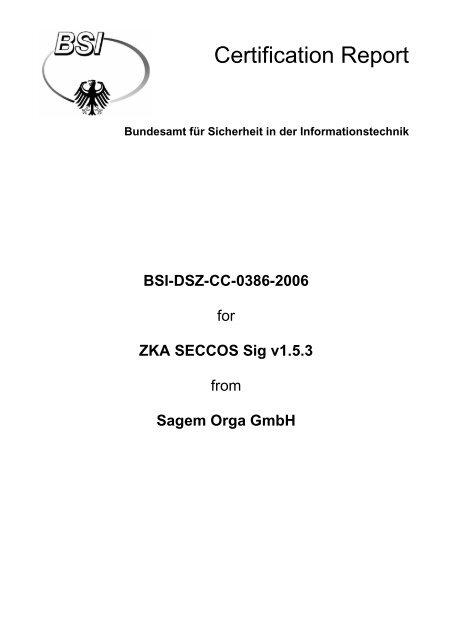
![[ST] System z10 EC LPAR Security Target V7.7.2 20081023 PU-205](https://img.yumpu.com/16227170/1/184x260/st-system-z10-ec-lpar-security-target-v772-20081023-pu-205.jpg?quality=85)
